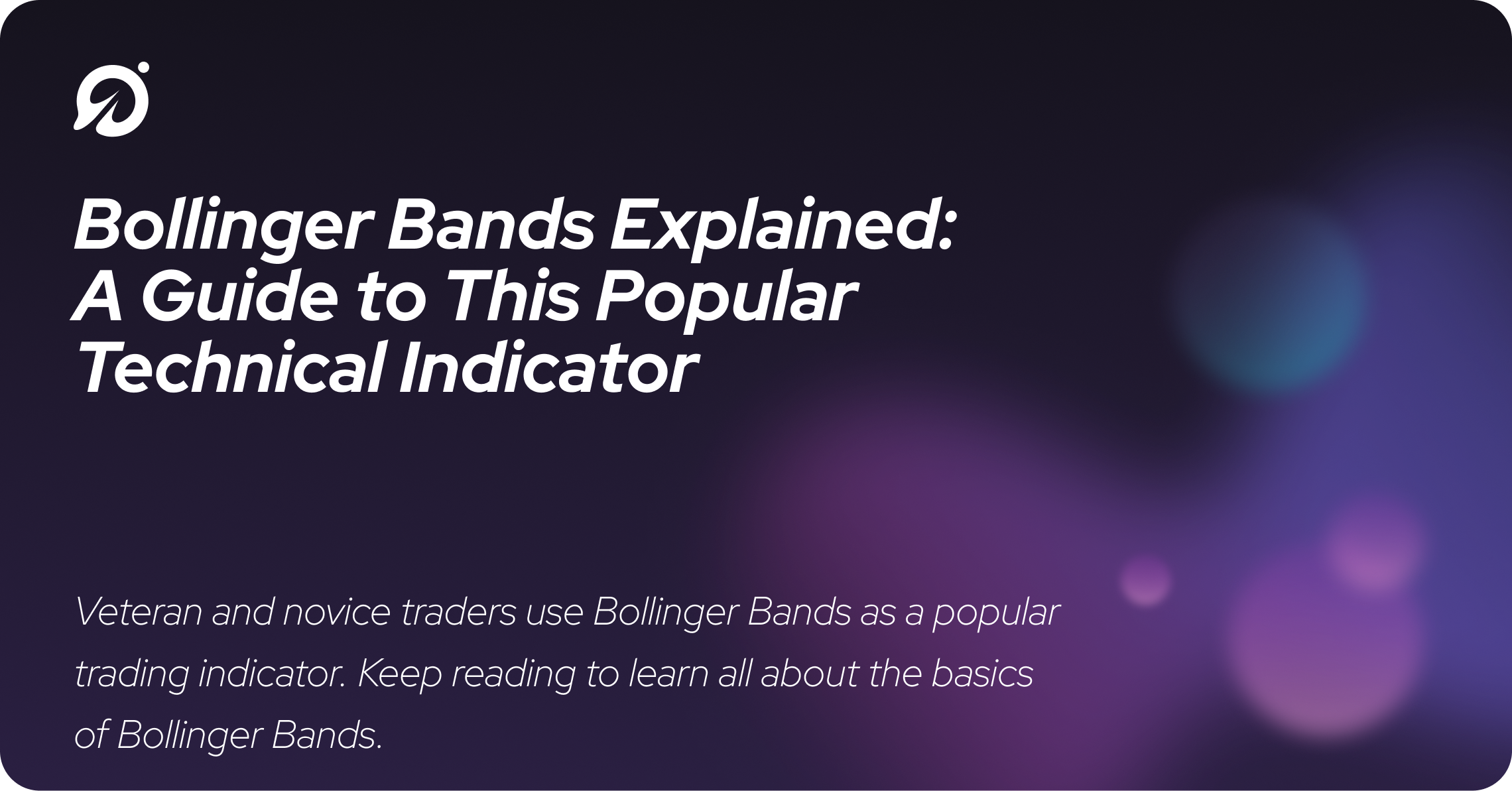Bollinger Bands Explained: A Guide to This Popular Technical Indicator
John Bollinger invented Bollinger Bands in 1983 to help stock traders evaluate price action. They are a popular trading indicator used by stock traders, crypto traders, and forex traders.

Disclaimer: This is for informational purposes and is not meant to serve as financial or investing advice.
Bollinger Bands just need historic price data to be calculated, meaning you can use them with any tradeable asset. Bollinger Bands help traders spot prices, identify breakouts, and gauge the momentum of an investment.
Trades watch price moves with the bands to recognize patterns and identify trade setups. Bollinger Bands themselves aren’t a standalone indicator for trades. They are more often used as a filter condition for trade setups.
How Do Bollinger Bands Work?
Bollinger Bands comprise two trendlines with two standard deviations above and below the simple moving average (SMA).
The default SMA used in Bollinger Bands is the 20-period SMA. The 20-period SMA takes the average closing price of an asset over 20 periods. The period depends on the chart timeframe you use. So if you look at a one-hour chart, it will be the 20-hour SMA.
The upper band indicates the zone where an asset is overbought, and the lower band shows it is oversold. Trades using Bollinger Bands use price’s position within the range to identify price trends.
The bands themselves will also compress and expand over time. As the price becomes more volatile, the bands will grow; as volatility decreases, the bands will compress.
What Are the Parameters for Bollinger Bands?
As mentioned above, the default period for the SMA is 20 days. And the default setting for the Bands themselves is two standard deviations.
To make the trendline and bands more sensitive to recent price changes, you can shorten the SMA period and vice versa to make it less susceptible to price changes.
You can also tweak the Bollinger Bands by the number of standard deviations the bands are from the SMA line. This is much less common than tweaking the SMA period.
How Can You Trade With Bollinger Bands?
To understand how you can trade with Bollinger Bands, we need to cover momentum trading and trend reversal. Let’s get into it.
What Is Momentum Trading?
Momentum trading is a strategy that seeks to capitalize on emerging price trends. These are called continuances. The idea is that you should buy solid charts and sell weak charts.
With Bollinger Bands, the price gains momentum when it breaks above the middle line (SMA) and moves toward the upper Bollinger Band.
Diverging from the SMA signals that price momentum is picking up, and if prices punch through either band, that can signal a further breakout. Momentum trading can be risky as you risk entering a trade late.
You can look at other indicators like RSA or MACD to judge if an asset is overbought or oversold. Momentum trading can be incredibly successful when market conditions match the direction of the trade.
Momentum trading can also take advantage of events-based trading. Events-based trading describes when you directionally trade on news stories like earnings reports, regulation changes, or geopolitical events.
If a stock is trending toward the upper band and you are bullish on an upcoming earnings report, you might enter a momentum trade. The idea is that the stock has momentum for good technical indicators, and the news will drive prices further upward.
What Is Trend Reversal?
When the price taps the upper or lower Bollinger Bands, it signals imminent price reversal. Remember, these bands are two standard deviations from the SMA or average price.
Mean reversion theory says that what goes up must come down. Mean reversion is like gravity in financial markets, and prices react accordingly.
Mean reversion traders use Bollinger Bands as a channel to trade in. When a price is at the bottom of the channel and reaches support, mean reversion predicts it should uptrend back to the middle band. Conversely, if the price is in the upper half of the channel, there should be a downtrend toward the SMA.
But remember, the bands themselves aren’t static. They adjust over time in response to the price movement, so they won’t always trade cleanly in the channel.
What Are Breakouts?
Using Bollinger Bands to trade breakouts is one of the most popular strategies. When the price goes above or below a Bollinger Band, it indicates that the price is breaking out. This can lead to sharp increases or decreases in price.
Algorithmic traders use these parameters to spot breakouts and capitalize on them. You can do this manually or by deploying your automated strategy.
What Is the Squeeze Strategy?
During low volatility, the Bollinger Bands will get closer together. This signals an opportunity for a stock squeeze.
After this lower volatility or consolidation period, look for a breakout in either direction. This is an excellent opportunity for a short-term directional trade.
However, it can be challenging to determine which way a stock will squeeze with Bollinger Bands alone. You will need to combine other indicators like the relative strength index (RSI) and volume to reach that conclusion.
How Can You Use Bollinger Bands in Advanced Technical Analysis?
Bollinger Bands are especially helpful when combined with other technical indicators. Here are a few indicators that are commonly paired with Bollinger Bands.
Bollinger Bands with RSI
RSI is a momentum indicator that compares the days an asset has closed up versus down in a given period. RSI ranges from 0 to 100.
When used with Bollinger Bands, RSI can confirm or invalidate price trends. RSI is especially useful when trading Bollinger Bands with a squeeze strategy. Remember that an RSI below 20 is oversold, while an RSI above 80 is overbought.
If Bollinger Bands are indicating a squeeze and RSI is low, that could predict the price will trend upwards.
Bollinger Bands and Moving Averages
Moving averages are trendlines that smooth the historical price on a chart. Depending on the timeframe and weighting of moving averages, you can dial them in to reflect recent or long-term price trends.
A method for combining moving averages with Bollinger Bands is to overlay an SMA with a shorter timeframe than the 20-day SMA. Its movements within the Bollinger Bands can be used to predict price trends.
Moving averages are very versatile tools when used with Bollinger bands. You can test different moving average types, timeframes, and periods to see what fits your trading strategy.
Bollinger Bands and MACD
MACD (or moving average convergence/divergence) is used to confirm price movements. MACD is calculated by subtracting the 26-period EMA from the 12-period EMA.
If you recognize a squeeze or breakout with Bollinger Bands, you can look to MACD for confirmation. If the price is trending up, but MACD is low, that signals a “divergence” and is a sell signal.
If MACD increases with price and a Bollinger Band compression, it may indicate a bullish price trend.
MACD with Bollinger Bands helps traders avoid trend failures or market fakeouts.
Timeframe
Like moving averages, you can use Bollinger Bands on many different timeframes. For instance, a day trader can use Bollinger Bands on the 5-minute chart to identify small short-term breakouts.
A long-term investor might use the daily chart to identify long-term price movements. Most traders formulate actionable trades using hourly, four-hour, and daily charts.
What Are Keltner Bands?
Keltner Bands or Keltner Channels are a popular alternative to Bollinger Bands. Like Bollinger Bands, Keltner Channels have a middle trendline and upper and lower bands.
Unlike Bollinger Bands, the middle Keltner Channel is the 20-period exponential moving average (EMA). The EMA differs from the SMA because it grants more weight to recent price data. This means Keltner Channels are more sensitive to recent price trends.
The upper and lower bands of Keltner Channels are also calculated differently than Bollinger Bands. They are calculated using the average true range (ATR), which measures volatility over time.
Moves above and below the upper and lower Keltner Bands are rare. Keltner Channels are used to spot potential breakouts and other sharp movements in price.
The main advantage of Keltner Channels over Bollinger Bands is that ATR smoothes the bands compared to Bollinger. Extreme price movements can bias Bollinger Bands.
Keltner Channels also tend to be tighter than Bollinger Bands. To study this effect further, you can overlay Bollinger Bands and Keltner Channels on the same chart.
What Are the Limitations of Bollinger Bands?
Bollinger Bands shouldn’t be used by themselves to develop a trade. The inventor John Bollinger himself recommended using two or three other indicators in tandem. His favorites include MACD and RSI.
Another critical point to remember is that Bollinger Bands use the SMA. The SMA weights older price data equal to newer. So depending on the configuration, Bollinger Bands can be a lagging indicator.
When trading, it’s always essential to know support and resistance levels. Even if your Bollinger Band strategy indicates a breakout, it’s unlikely to reach the next resistance level. Understanding volume is vital to trading around support and resistance levels.
Because Bollinger Bands expand and compress with volatility, they behave differently with different assets and asset classes. Novice traders should study their behavior across several assets before using them to inform trade decisions.
How Can You Use Bollinger Bands?
Bollinger Bands are versatile trading indicators you can use in many trading strategies. Pioneered in the 80s, Bollinger Bands are one of the oldest indicators used regularly today. Traders use them to identify trends, reversals, breakouts, and squeezes.
The middle band is calculated using the 20-period SMA of your chart, and the outer bands are two standard deviations away from the SMA. A savvy trader may tweak the SMA period to zoom in or out on the asset’s average price over time.
Bollinger Bands distill essential information about trading momentum into an easily readable chart. They are great for quickly capturing price volatility and price trends. They can also confirm trading signals.
The Bottom Line
Like all trading indicators, Bollinger Bands are not a silver bullet. They should be used together with other indicators like MACD, RSI, or moving averages. A popular alternative to Bollinger Bands is the Keltner Channel which accounts for more volatility than Bollinger Bands.
Ready to brush up on other indicators and trading strategies? Check out the Pluto blog for more deep dives.
Sources:
What Is SMA? - Simple Moving Average | Fidelity
